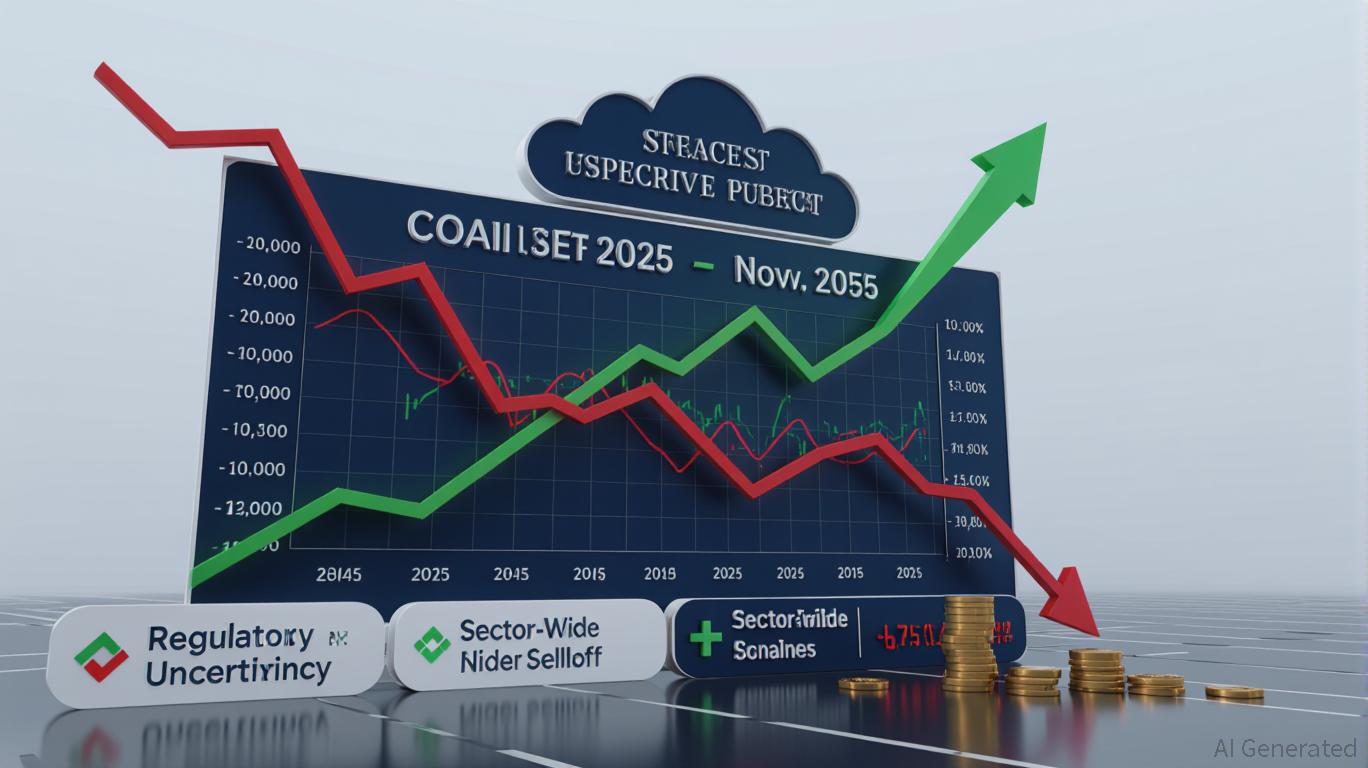Bitcoin’s Abrupt Price Swings in Late 2025: Broader Economic Risks and Ripple Effects in the Derivatives Market
- Bitcoin's late 2025 volatility reached critical levels due to macroeconomic pressures, derivatives spillovers, and regulatory shifts. - Derivatives liquidations exceeded $20B as leverage ratios hit 1,001:1, with Bitcoin longs accounting for $499.89M in October 2025 losses. - Regulatory clarity boosted institutional participation but exposed vulnerabilities, as Q4 saw $1.22B in Bitcoin ETF outflows amid AI fears and Fed tightening. - Geopolitical shocks like U.S.-China tensions triggered 14% Bitcoin crash
Institutional Sell-Offs and Derivatives Market Shifts
By late 2025, the derivatives sector emerged as a significant source of systemic risk. In the third quarter, daily trading in derivatives averaged $24.6 billion, with perpetual futures accounting for 78% of the volume, as reported by
While Ethereum was hit hardest, Bitcoin also faced significant losses. In one 24-hour window in late October 2025, global crypto liquidations reached $1.73 billion, with $499.89 million coming from Bitcoin long positions, per
Centralized exchanges like Binance saw a spike in deposits as traders rushed to protect themselves from further declines, according to At the same time, decentralized exchanges such as Hyperliquid captured 73% of DEX derivatives trading, indicating a redistribution of risk, as noted by
Regulatory Shifts and Institutional Trust
Clearer regulations proved to be a double-edged sword. Announcements from the U.S. SEC and CFTC in September 2025, along with the rollout of MiCA in Europe, initially encouraged more institutional involvement, according to
Nevertheless, optimism about regulation was tempered by underlying risks. The October 10 downturn—sparked by renewed trade disputes between the U.S. and China and assertive statements from President Trump—highlighted a shift in Bitcoin’s market leadership from individual investors to institutions, as noted by
Crypto Fund Withdrawals and Market Mood
The wave of withdrawals in Q4 2025
Large holders selling off further intensified the outflows. Coinglass data showed that as institutions closed out leveraged bets, Bitcoin’s futures curve flattened, as reported by
This set off a feedback loop: falling prices led to more forced sales, which in turn deepened negative sentiment.Macroeconomic and Geopolitical Catalysts
In addition to derivatives and regulatory factors, broader economic trends played a crucial role. The October 10 selloff, which saw Bitcoin tumble 14% within hours, was directly tied to escalating U.S.-China trade tensions, according to
Elsewhere, the total crypto market capitalization shrank by 2% to $3.39 trillion in late 2025, according to
reflecting widespread selling. Alternative coins such asConsequences and Prospects
The turbulence in Bitcoin’s price during late 2025 underscores the growing impact of macroeconomic forces and the feedback effects of leveraged trading. While clearer regulations have strengthened institutional trust for the long term, the sector’s dependence on leverage remains a key risk. AI-driven forecasts now suggest Bitcoin could reach $170,000–$185,000 by early 2026, according to
but this outlook depends on resolving economic challenges and stabilizing the derivatives market.Investors should stay alert. The combination of capital outflows, liquidation spirals, and geopolitical shocks highlights the importance of adaptive risk strategies. As the crypto industry evolves, the boundary between innovation and systemic risk will continue to
Disclaimer: The content of this article solely reflects the author's opinion and does not represent the platform in any capacity. This article is not intended to serve as a reference for making investment decisions.
You may also like
Bitcoin News Today: Bitcoin Poised for Major Move: Will It Surge or Plunge at $108K?
- Bitcoin consolidates near $104.5K, below $108K resistance, as tightening Bollinger Bands signal potential breakout. - A $108K+ break could drive BTC to $110K-$112K with ETF inflows and reduced miner selling pressure supporting accumulation. - Failure to hold $104K support risks a pullback to $100.5K, with soft ETF demand or renewed miner sales as key triggers. - Solar stocks like Emeren and Canadian Solar draw equity market attention amid mixed earnings and debt concerns.

Tokenized Equities Climb to $10 Billion, Putting Regulators in a Legal Gray Area
- Kraken's xStocks platform, a joint venture with Backed, surpassed $10B in transaction volume four months post-launch, tokenizing equities like Tesla and Meta . - The platform enables 24/7 trading and fractional ownership across Ethereum , Solana , BNB Chain, and Tron , with $2B in onchain activity and 45,000 holders. - Legal ambiguity persists as tokenized stocks are treated as derivatives, not direct securities, with experts warning of liquidity risks and regulatory challenges. - Kraken's cautious focus
Bitcoin Updates: Dubai Court's $456 Million Asset Freeze Marks a Turning Point in International Crypto Regulation
- Dubai's Digital Economy Court froze $456M in TrueUSD reserves, alleging mismanagement by Aria Commodities, a firm controlled by Matthew Brittain. - Funds were transferred via Hong Kong-based First Digital Trust between 2021-2022, sparking legal disputes over whether reserves were converted to illiquid assets. - The ruling underscores global regulatory focus on stablecoin transparency, as Techteryx claims constructive trust while Aria faces scrutiny over opaque transactions. - Trump-linked entities like A

COAI's Sudden Price Decline: Managing Immediate Fluctuations and Sustained Strength
- COAI Index fell 54% by November 2025 due to C3.ai's $116.8M loss, lawsuits, and regulatory uncertainty from the CLARITY Act. - Short-term selloffs were amplified by sector-wide risk aversion, though Binance's smart money account profited $3.125M from COAI trades. - Long-term resilience stems from 50+ corporate partnerships advancing AI adoption and indirect benefits from rising AI R&D investments in biotech . - Investors must balance regulatory risks with COAI's ecosystem strength, as C3.ai's struggles c
